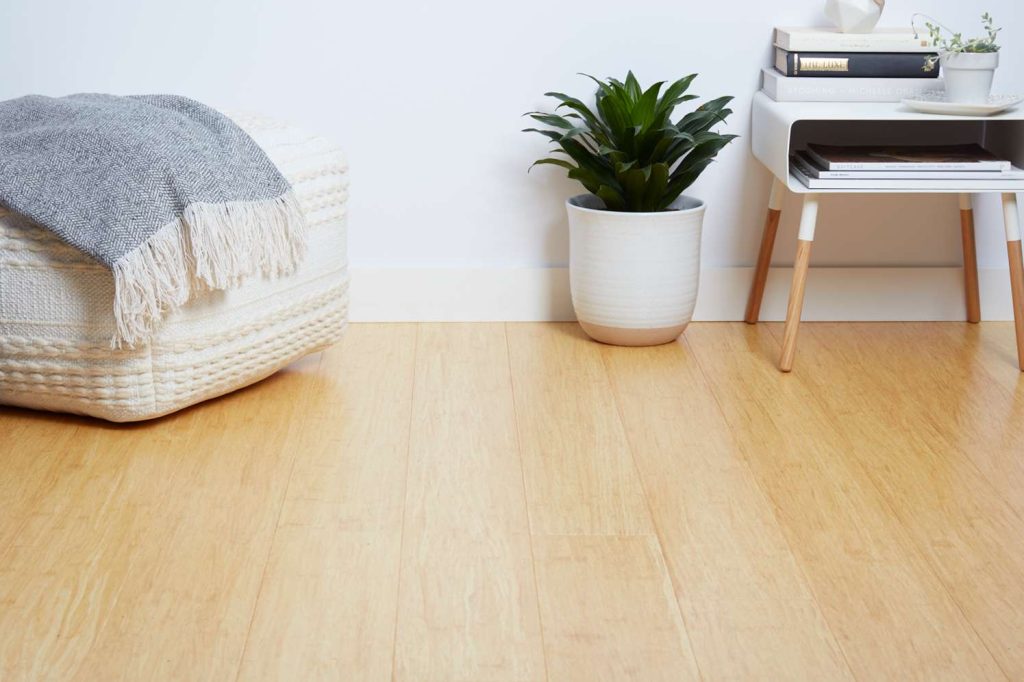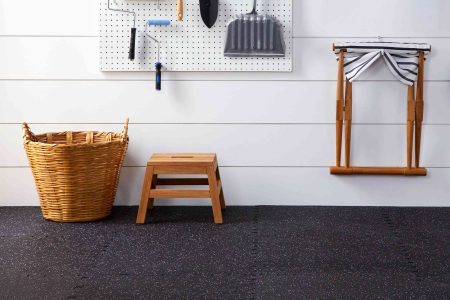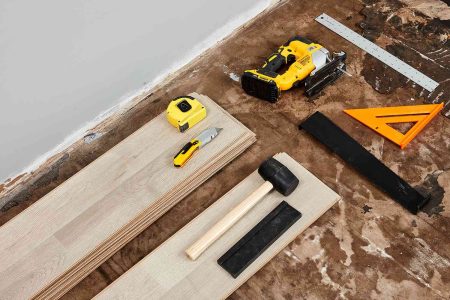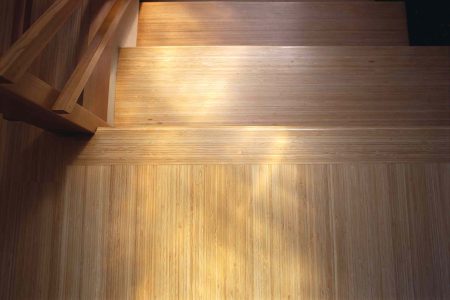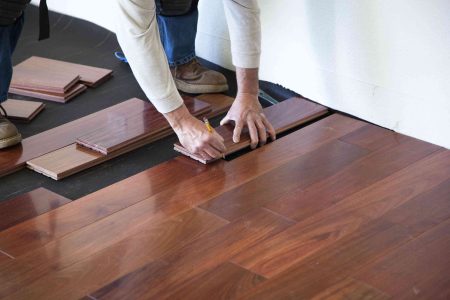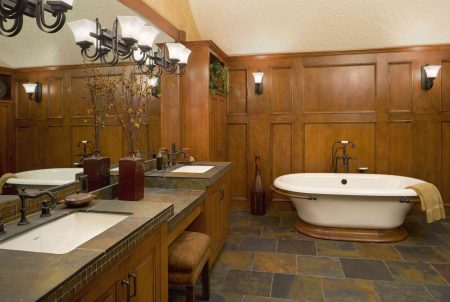As a flooring material, bamboo has many of the same benefits and drawbacks of hardwood flooring, Like wood flooring, bamboo is an attractive natural material that generally adds real estate value to a home. But like wood, bamboo can be scratched, and it is prone to cracking in conditions where humidity levels swing dramatically.
What Is Bamboo Flooring?
While the bamboo plant is a type of grass, not a tree, bamboo flooring behaves much like wood flooring—it can even be refinished in the same way. Bamboo is every bit as hard as most hardwoods and is highly resistant to moisture.
Bamboo will be of most appeal to consumers interested in using natural, renewable resources. Unlike trees, which require at least 20 years to mature, a bamboo stalk can be repeatedly harvested every five or six years. Most commercial bamboo comes from plantation-like operations that are farmed responsibly.
-
Renewable material
-
Easy maintenance
-
Can be refinished
-
Adds real estate value
-
Easily scratched
-
Humidity swings can cause cracks
-
Toxins present in adhesives
Watch Now: Pros & Cons of Bamboo Flooring
Manufacture of Bamboo Flooring
There are several different types of bamboo flooring, each with its own manufacturing process.
Stranded bamboo is made by shredding the bamboo stalks into small strands, which are compressed into sheets using heat and resin binders, then cut into planks to use as building materials. This form of flooring is available both as tongue-and-groove planks that are nailed down, as well as planks that float over the underlayment. This is a premium form of bamboo flooring, available in many colors.
Horizontal bamboo flooring is manufactured by cutting the strands into thin strips which are then glued together to form planks. This type of flooring has a “grain,” since the long stalk fibers are visible in the flooring. This type of bamboo is not as hard or durable as stranded bamboo, but it can have a very striking appearance. It, too, is available both in nail-down planks and as floating floor planks.
Engineered bamboo flooring is made by bonding a thin layer of bamboo onto a plywood or MDF core. This flooring is comparable to engineered hardwood and is installed in the same way—usually with click-lock planks that float over a foam underlayment. It is the least expensive (and least durable) form of bamboo flooring, and it cannot be refinished.
Unless it is stained, most bamboo flooring has a natural blonde or amber color that resembles unfinished maple or birch, but darker tones are available through a process called carbonizing, which entails subjecting the planks to high temperatures. While the color can be very attractive, carbonized bamboo is softer than uncarbonized forms, and is more susceptible to scratching.
Eco-Friendliness
Environmentally conscious consumers are often drawn to bamboo as a wholly renewable resource. Unlike the hardwood lumber industry, where trees can take decades to mature, bamboo stalks grow so fast that there is little environmental liability to the harvest practices. Moreover, bamboo stalks that are cut simply continue to grow and replenish themselves so that they can be harvested.
But the manufacturing process creates other environmental concerns. Bamboo floor planks are manufactured by slicing or shredding the stalks of bamboo grass plants and then compressing the pulp back together using heat, pressure, and a resin-based adhesive identical to those used in many other flooring products. This adhesive often contains urea-formaldehyde that can outgas into the air.
The level of adhesive used and the amount of toxins emitted will vary, depending on how the bamboo planks are manufactured. Cheaper products may contain more formaldehyde, while more expensive products may use alternative materials in the resins. The amount of formaldehyde used in bamboo flooring is similar to that found in engineered hardwood flooring or MDF sheathing, and it tends to be a problem only for sensitive individuals. But if this concerns you, look for bamboo products labeled as formaldehyde-free.
Bamboo Flooring Cost
This material is priced at about the same level as most hardwood floors. You can find bamboo flooring products ranging from about $2 to $8 per square foot, with a national average of $3.84 per square foot. Installation costs for bamboo flooring are much the same as for hardwood flooring. On average, figure on adding about $4 per square foot for installation labor in addition to the cost of materials. You should be able to get a good-quality bamboo installed for less than $10 per square foot, including materials and labor.
If you are a DIYer, be aware that there is no independent system for rating the quality of bamboo materials in the same way that hardwood is graded. Retailers will often sort lots into grade A and grade B materials, but that is an arbitrary system that means different things to different retailers. This makes it important to find a quality, reputable flooring dealer to ensure that you are getting top-quality material.
Maintenance and Repair
Bamboo is relatively easy to maintain. Just sweep or vacuum it regularly to remove small particle debris. You can also occasionally damp mop it or clean it with a non-wax, non-alkaline, hardwood or bamboo floor cleanser.
When compared to hardwood, bamboo is slightly more resistant to water damage. And bamboo is slightly harder than many hardwoods, giving it somewhat better resistance to scratches and dents. But this is not a water-proof or scratch-proof material. Take care to protect the floor against standing water and from scratches. Because it is an organic material, bamboo can be affected by mold if water is present. Bamboo can be discolored if it gets too much direct sunlight, so it is best to use shades or blinds in rooms that get direct sunlight.
Over time, bamboo floors may become discolored, scratched, or marred. Luckily, the surface of this material can usually be refinished by sanding it down and then reapplying sealing coats. Engineered bamboo flooring, however, usually cannot be refinished.
Humidity affects bamboo somewhat more severely than it does hardwood flooring. If the flooring is installed in a very humid climate, the moisture in the air can cause the floor planks to swell and buckle, while in a dry environment, the planks can shrink. In conditions of extremely high or extremely low humidity, bamboo flooring is more likely to crack than is hardwood flooring.
Design
Bamboo is a trendy flooring material that can elevate the elegance of a space almost instantly. It has an appearance and a feel that is similar to hardwood and yet is still distinct and different. Like cork flooring, bamboo is a good material for consumers who like something different, or who want to make a statement by using a renewable resource. Aesthetically, bamboo can work with almost any home style, though it is best suited for contemporary settings.
Bamboo Flooring Installation
Bamboo flooring comes in several different types of products:
Solid bamboo planks are installed much the same was as solid hardwood. The tongue-and-groove boards are usually blind-nailed to the subfloor through the edge of the boards. Solid bamboo planks can also be glued down over an existing concrete floor. Installation of nail-down or glue-down bamboo planks is usually handled by professionals.
There are also thinner forms of solid bamboo designed for floating floor installation. Floating bamboo floors sometimes use a modified tongue-and-groove system known as “click-lock,” in which the edges of the boards interlock mechanically. Or, the planks may have a standard tongue-and-groove design, where the edges of the boards are glued together. Either way, the entire floor rests over a thin layer of foam underlayment, with no permanent attachment to the subfloor. This installation method is easier for DIYers, and it also has the advantage of allowing the floor to expand and contract as humidity levels change.
Engineered bamboo is manufactured with a surface veneer bonded to a plywood or MDF core. These products always use the click-lock floating floor installation method. Engineered bamboo is less expensive than solid bamboo, and it is usually installed by DIYers.
Most bamboo flooring products are prefinished at the factory, but if not, the flooring needs to be sealed with a urethane product after installation. Raw bamboo planks can also be stained before top-coating with a urethane sealer.
Bamboo vs. Hardwood Flooring
With bamboo and hardwood flooring having similar characteristics and costs, making a choice between the two is not always easy. Bamboo typically is lighter in color than most hardwoods, although you can also find darker versions that have been “carbonized.” Bamboo also has a more uniform texture and grain, unlike hardwood, in which each board has a unique grain pattern. Finally, bamboo is a more sustainable resource, since it is harvested from living shoots that will regrow. No forests are harvested to make bamboo flooring. Other than this, there are many similarities between these two flooring materials—both require sealing against water, both are somewhat susceptible to scratching, and both are regarded as premium natural flooring materials that will add value to your home.
Top Brands of Bamboo Flooring
Most of the major hardwood flooring manufacturers also carry a selection of bamboo flooring products. For the best selection and product quality, however, it’s a good idea to check out the manufacturers who specialize in bamboo:
- Plyboo: This company uses a soy-based resin that contains no formaldehyde. It makes for a more expensive product (as much as $6 per square foot), but these are products are among the most beautiful of any bamboo flooring, as well as the most healthful.
- Cali Bamboo Flooring: This company sells more than 30 different bamboo flooring products, including both solid bamboo and engineered bamboo in various colors. They also include some bamboo flooring products designed for good performance in high-moisture situations.
- Teregren: This company is known for its sustainable farming practices and good treatment of its labor force. Its bamboo flooring products are considered among the best in quality.
- Ambient Bamboo Floors: This company makes formaldehyde-free flooring. Most of its offerings are made from stranded bamboo that create a very striking look.
Comfort and Convenience
In most ways, bamboo floors perform in much the same way as hardwood. For the most part, these floors are non-allergenic, although some people with chemical sensitivities can react to the small amounts of formaldehyde and VOCs that are present in the resins. If this is your situation, there are some very good bamboo flooring products that omit these chemicals.
Read the full article here



